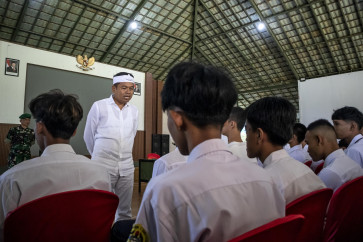Popular Reads
Top Results
Can't find what you're looking for?
View all search resultsPopular Reads
Top Results
Can't find what you're looking for?
View all search resultsMuseum satisfies curiosity about Indonesian puppetry
On their day off on Tuesday, private employee Habi Asmoro, 22, talked his cousin Indiana, 22, and his aunt Iis Rinawati, 46, into visiting the Wayang Museum located in Kota Tua in West Jakarta
Change text size
Gift Premium Articles
to Anyone

O
n their day off on Tuesday, private employee Habi Asmoro, 22, talked his cousin Indiana, 22, and his aunt Iis Rinawati, 46, into visiting the Wayang Museum located in Kota Tua in West Jakarta.
“We decided to visit because we are of Javanese descent but we [her and her daughter] know nothing about wayang and have never seen a [wayang] performance,” said Iis, a resident of Cikarang, Bekasi regency, West Java.
Wayang is an Indonesian puppetry art form that is usually used to tell legendary tales such as the Hindu epics of Ramayana and Mahabharata, as well as local legends. Traditionally, puppet masters perform ritualized midnight-to-dawn shows.
On Nov. 7, 2003, UNESCO declared wayang a world intangible cultural heritage.
Habi said he insisted on visiting the museum because he was curious about the art form. “I know very little about wayang legends like Mahabharata,” he said, while reading attentively about the genealogy of the figures from the Mahabharata epic.
He said that he had watched wayang performances during special events like Independence Day celebrations. “I have also watched on YouTube,” he said.
Habi and his family, however, had to be satisfied with only seeing the thousands of wayang puppets on display at the museum as wayang shows are only performed on Sundays.
Effianti, a staff member at the museum, said the museum had a collection of 6,000 wayang puppets from around the country, as well as various other kinds of puppets from around the world.
The museum, located facing Fatahillah Square, is one of the city’s most popular tourist attractions.
According to Effianti, the museum welcomed up to 700 visitors on weekdays and up to 2000 people on national holidays, with visitors required to pay an entrance fee of Rp 5,000 (US3 cents).
The building was originally a church built by the Dutch East Indies Company (VOC) in 1640. Over the centuries, the building has been used as a church, a warehouse and a research center. Near the entrance, people can see several epigraphs, one of which is a memorial to VOC governor general Jan Pieterszoon Coen, who is rumored to have been buried near the building.
In 1975, the building was turned into a wayang museum by then Jakarta governor Ali Sadikin.
Another visitor, Piers Masterson, a 48-year-old contemporary art writer from London, said that he had learned about wayang from an Indonesian friend of his.
He said he had previously seen wayang puppets at the British Museum in London, brought over by Thomas Stamford Raffles. However, he said the ones he saw were over 200 years old, while the Wayang Museum had newer items.(dis)









